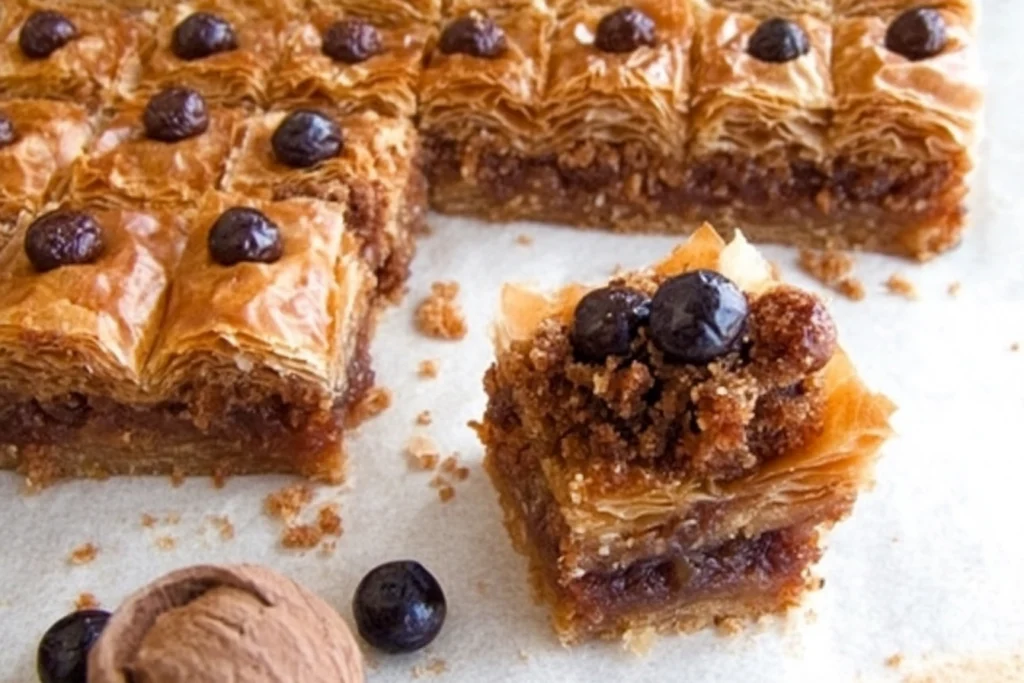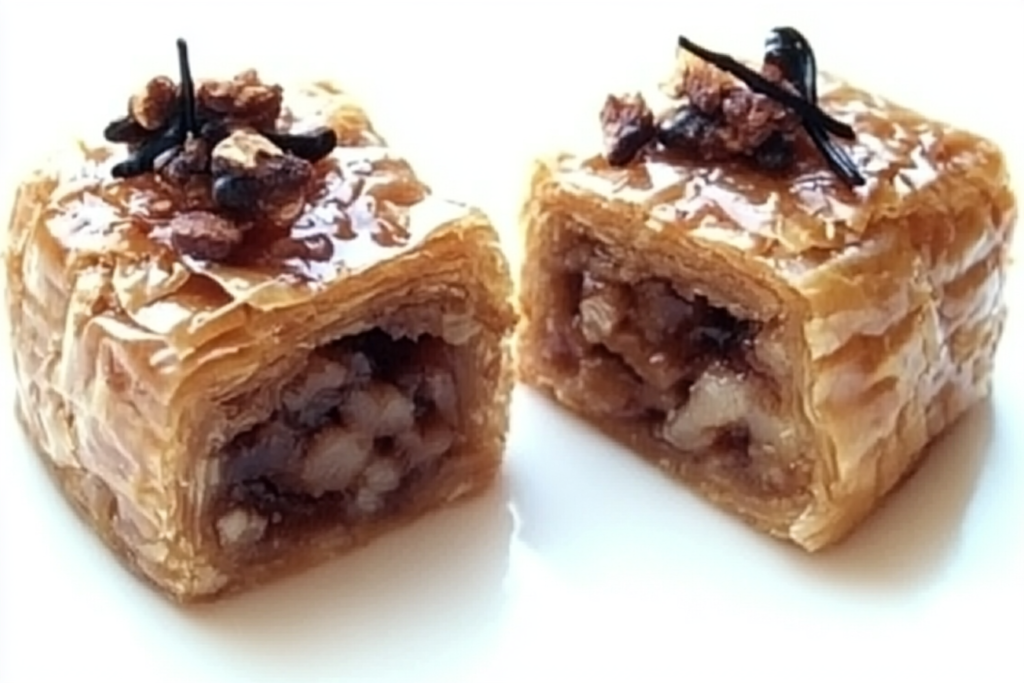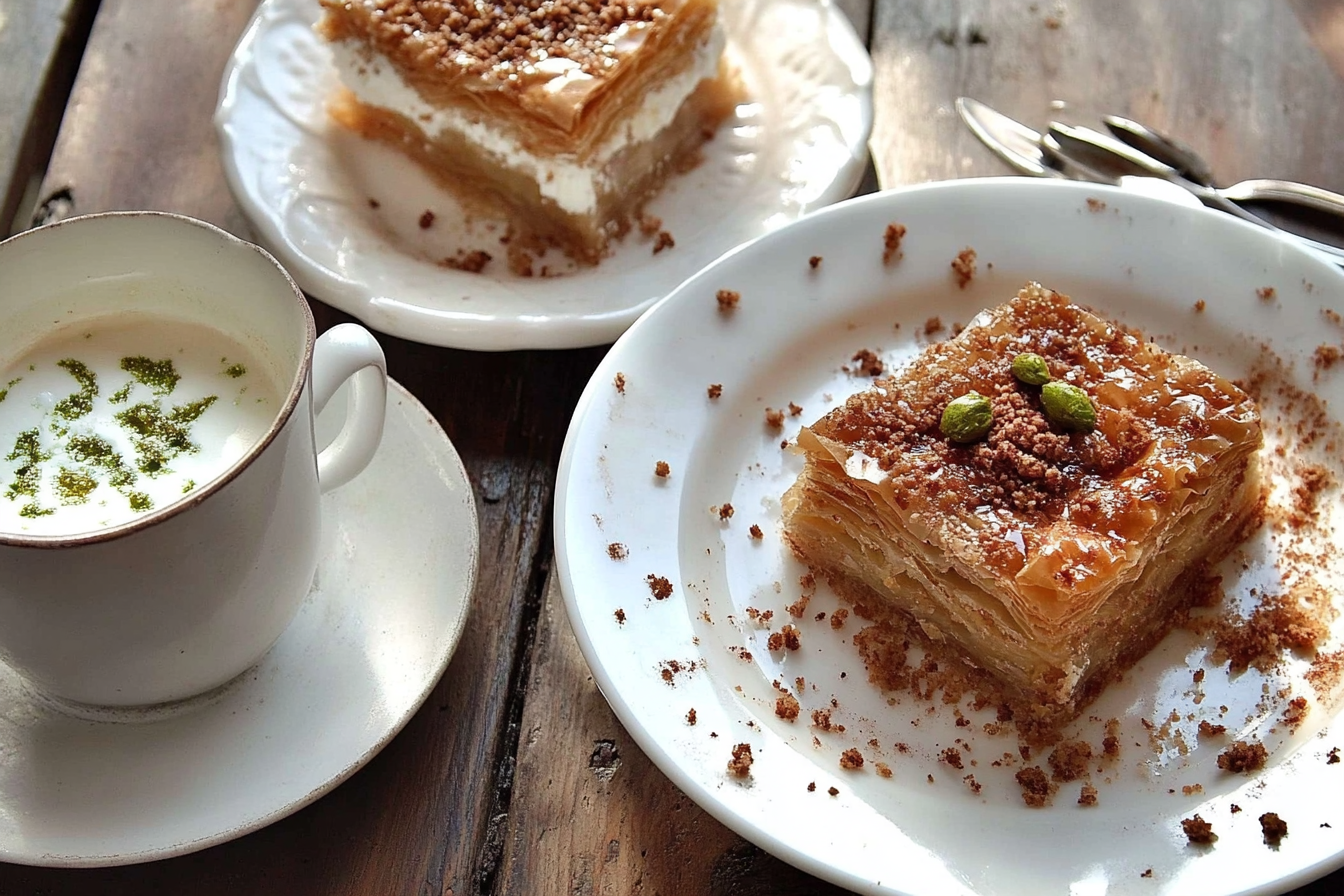The Unique Identity of Greek Baklava
People across the globe cherish baklava for its layers of crispy phyllo dough, sweet fillings, and syrupy finish. Among its many regional variations, Greek baklava stands out due to its ingredients, preparation techniques, and cultural roots. Greek baklava relies on honey-based syrups, unique regional nuts, and spices that give it a distinct flavor profile.
Unlike other versions, Greek baklava focuses on simplicity and balance. Bakers layer thin sheets of phyllo dough with coarsely chopped nuts, drizzle honey syrup, and finish with warm spices to create a dessert that highlights natural flavors and textures.
Origins of Greek Baklava
The history of Greek baklava intertwines with the nation’s cultural and culinary traditions. Influences from both the Byzantine Empire and Ottoman Empire helped shape the dessert into what it is today.
- Byzantine chefs crafted early versions of layered pastries with sweeteners and nuts, making them a symbol of wealth and celebration.
- Ottoman culinary practices introduced spices, advanced baking techniques, and syrups, which further enriched baklava recipes.
Over centuries, Greek households adopted and refined the dessert. Families often prepared baklava for weddings, holidays, and religious celebrations, cementing its place as a symbol of hospitality and festivity.
Key Features of Greek Baklava
Core Ingredients
Greek baklava emphasizes high-quality, natural ingredients.
- Nuts: Walnuts dominate most recipes, although pistachios or almonds sometimes appear.
- Honey Syrup: Unlike sugar syrups used in other varieties, Greek baklava uses honey, which adds a floral aroma and natural sweetness.
- Phyllo Dough: Thin sheets of phyllo create the dessert’s flaky, crisp texture.
Flavor Profile
The combination of sweet honey, nutty richness, and aromatic spices like cinnamon and cloves gives Greek baklava its distinctive flavor. Bakers ensure these flavors remain balanced, allowing each element to shine.
Greek Baklava vs. Turkish Baklava
Greek and Turkish baklava differ in several significant ways:
- Syrup: Greek baklava uses honey-based syrup, while Turkish recipes rely on sugar-based syrups for a denser sweetness.
- Nuts: Greek baklava typically highlights walnuts, whereas Turkish baklava often features pistachios.
- Texture: Greek baklava has a crispier finish due to the phyllo preparation and lighter syrup application.
These differences create distinct versions of baklava, with Greek baklava emphasizing simplicity and natural flavors.
Preparation Style
Layering Techniques
Greek baklava requires precision and attention to detail. Bakers layer phyllo sheets, brushing each one with melted butter to create an even, golden finish. They alternate layers of nuts with the phyllo, building a dessert that is as visually appealing as it is delicious. The layering process ensures a perfect blend of flaky pastry and rich filling.
Phyllo Dough
Greek recipes use numerous sheets of ultra-thin phyllo dough—sometimes exceeding 30 layers. This attention to detail gives the dessert its signature crispiness and delicate structure.
Syrup in Greek Baklava
Greek baklava’s syrup serves as a defining feature. Bakers create the syrup with honey, often adding lemon juice or orange zest for brightness and depth. After baking, they pour the hot syrup over the cooling baklava, allowing it to soak into every layer. This method ensures the dessert achieves the ideal balance of moisture and crispness.
Nuts in Greek Baklava
Nuts add richness and texture to Greek baklava.
- Walnuts: These are the most common choice, offering a mild and earthy flavor.
- Pistachios and Almonds: Bakers sometimes include these nuts for variety.
- Coarseness: Greek baklava relies on coarsely chopped nuts to provide a satisfying crunch in every bite.
Bakers often mix cinnamon and cloves with the nuts to enhance the dessert’s aroma and flavor.
Role of Spices
Spices elevate the flavors in Greek baklava. Cinnamon and cloves take center stage, creating warm and fragrant undertones. Some recipes include citrus zest or nutmeg for additional layers of complexity. These spices not only add depth but also highlight the dessert’s connection to Greek culinary traditions.
Shape and Presentation
Greek baklava often appears in diamond-shaped portions, which makes it both visually striking and easy to serve. Bakers sometimes garnish the dessert with chopped nuts or drizzle extra honey over the top for added appeal.
Regional Variations in Greek Baklava
Greece’s diverse regions offer unique interpretations of baklava:
- Mainland Recipes: These versions use walnuts more prominently and include extra phyllo layers for a heartier texture.
- Island Recipes: Lighter in composition, these versions often incorporate local honey and citrus zest for a fresh flavor profile.
- Seasonal Twists: During holidays like Christmas or Easter, bakers may add more spices or decorative touches to reflect the festive spirit.
These variations showcase baklava’s versatility and its ability to adapt to regional tastes.
By reducing the passive voice and emphasizing an active, engaging tone, this version improves readability and clarity.
How Greek Baklava Stands Out
Simplicity in Ingredients
Greek baklava stands apart because of its focus on natural and high-quality ingredients. Unlike some variations that use additives or overly complex syrups, Greek baklava relies on the purity of its components. This simplicity highlights the authentic flavors of honey, nuts, and phyllo dough, creating a dessert that feels both indulgent and wholesome.
Greek baklava bakers prioritize:
- Locally sourced nuts like walnuts and almonds.
- Traditional Greek honey, which imparts a distinctive floral sweetness.
- Thin, hand-prepared phyllo dough for a crisp texture.
This minimalist approach ensures that each bite delivers the essence of its components without overwhelming the palate.
Honey-Based Sweetening
One of the hallmarks of Greek baklava is its use of honey-based syrup. Greek honey, known for its distinct regional varieties, plays a crucial role in the flavor profile:
- Thyme Honey: Commonly used in baklava, thyme honey provides a robust and slightly herbal note.
- Wildflower Honey: This variety adds a light and floral aroma, complementing the richness of the nuts.
- Citrus-Infused Syrup: Many recipes include lemon or orange zest in the syrup to brighten the flavor.
By contrast, many other baklava variations use sugar syrups, which result in a denser sweetness. Greek baklava’s reliance on honey creates a lighter, more natural taste.

Phyllo Dough in Greek Baklava
Phyllo dough plays a pivotal role in Greek baklava’s appeal. Greek bakers pay close attention to its preparation, ensuring the dough achieves the perfect balance of thinness and durability. The hallmark features of Greek phyllo include:
- Thinness: The dough is rolled paper-thin, contributing to the dessert’s flaky and crispy texture.
- Crispness: Each sheet is brushed with melted butter, ensuring even browning during baking.
- Structure: Despite its delicate appearance, Greek phyllo maintains its integrity, holding the layers together without collapsing.
This dedication to phyllo preparation ensures that every bite offers a satisfying crunch.
Layering Techniques
The artistry of layering sets Greek baklava apart. Bakers alternate thin layers of phyllo dough with generous portions of nut filling, creating a dessert that is as visually stunning as it is delicious. The process involves:
- Starting with several buttered phyllo layers to form a strong base.
- Adding a layer of coarsely chopped nuts mixed with cinnamon or cloves.
- Repeating the process until the desired thickness is achieved.
- Topping with several layers of phyllo dough to create a golden, crisp finish.
Uniform buttering between layers ensures even baking and enhances the dessert’s texture.
Syrup Application Method
Greek baklava features a specific method of applying syrup, which contributes to its unique texture. Bakers pour hot syrup over the cooling baklava, allowing it to absorb the sweetness evenly without becoming soggy. This approach contrasts with some recipes that use cold syrup on hot baklava, which can result in uneven soaking.
By using the hot-on-cold method, Greek baklava achieves:
- A perfectly moist interior.
- A crisp, caramelized exterior.
- An even distribution of flavor throughout the layers.
This meticulous technique ensures that each piece of baklava delivers consistent sweetness and texture.
Texture Differences
Greek baklava offers a distinct textural experience, balancing crispness and chewiness:
- The crispy phyllo dough forms a golden, flaky shell.
- The coarsely chopped nuts provide a satisfying crunch.
- The honey syrup creates a slight chewiness in the middle layers without compromising the overall crispness.
This careful balance sets baklava apart from softer versions that use sugar syrups, which can make the dessert overly moist.
Greek Nuts as a Signature Touch
The nuts used in baklava significantly influence its flavor and texture. Local varieties of walnuts and almonds take center stage in many recipes, contributing an earthy and slightly sweet profile. These nuts differ from Turkish baklava’s preference for pistachios, which have a richer and more buttery taste.
Greek bakers emphasize:
- Coarse Chopping: The nuts are not ground too finely, ensuring a crunchy texture.
- Regional Sourcing: Greek walnuts, often sourced from mountainous regions, add a unique flavor that distinguishes the dessert from others.
By prioritizing these details, baklava celebrates its connection to the land and local traditions.
Greek Baklava’s Lighter Profile
Greek baklava tends to feel lighter compared to other versions of the dessert. The use of honey syrup instead of sugar reduces the overall sweetness, allowing the flavors of the nuts and spices to shine. Bakers also apply less syrup than some recipes, preventing the dessert from feeling overly rich or cloying.
This lighter profile makes baklava an ideal choice for those who appreciate a more balanced sweetness in their desserts.
Spices and Aromatics
Greek baklava derives its warmth and complexity from its careful use of spices:
- Cinnamon: Adds a sweet, woody depth to the nut filling.
- Clove: Introduces subtle aromatic notes that enhance the dessert’s flavor.
- Citrus Zest: Occasionally, bakers incorporate lemon or orange zest, which brightens the flavor and complements the honey syrup.
These spices not only add flavor but also connect Greek baklava to the broader Mediterranean culinary tradition.
Traditional Serving Customs
Greek baklava holds a special place in the country’s culture, often served during significant occasions:
- Pairing with Greek Coffee: The bold, bitter flavor of Greek coffee complements the sweetness of baklava, creating a harmonious balance.
- Symbol of Celebration: Families prepare baklava for weddings, Easter, and Christmas, using it as a gesture of hospitality and joy.
Serving baklava during these events reinforces its role as a cherished part of Greek tradition.
Greek Baklava: Cultural and Global Perspectives
Greek Baklava in Global Cuisine
Over time, Greek baklava has gained recognition as a culinary icon worldwide. Its simple yet refined preparation appeals to dessert lovers across cultures. Greek restaurants and bakeries abroad often feature baklava as a signature dish, introducing this unique dessert to new audiences.
Greek baklava has also influenced other Mediterranean and Western desserts. For example:
- Pastries like Italian sfogliatelle and French mille-feuille share similar layered techniques.
- The popularity of baklava has inspired innovations like baklava ice cream or baklava-flavored syrups.
Greek baklava’s ability to adapt while retaining its essence makes it a global favorite.
Role in Greek Celebrations
In Greece, baklava carries a deep cultural significance. Families often prepare it for special occasions, using traditional recipes passed down through generations. Key celebrations featuring baklava include:
- Weddings: Baklava symbolizes love and prosperity. It is served to guests as a sweet blessing for the newlyweds.
- Religious Holidays: Greeks prepare baklava for Easter and Christmas, incorporating additional spices or garnishes to reflect the festive spirit.
- Name Days: Baklava often appears at gatherings celebrating individuals’ name days, reinforcing its role in fostering connection and joy.
The dessert’s presence at these events underscores its role as a symbol of Greek hospitality.
Comparing Baklava Variants
While Greek baklava remains unique, other regional variants share similar foundations. Understanding their differences highlights what makes the Greek version distinctive:
- Turkish Baklava: Known for its use of pistachios and sugar-based syrup, Turkish baklava often has a softer texture compared to the crispness of Greek baklava.
- Middle Eastern Baklava: Versions from Lebanon and Syria frequently use rose water or orange blossom water in the syrup, creating a more fragrant flavor.
- Western Adaptations: In the U.S. and Europe, baklava often incorporates modern twists like chocolate or caramel fillings.
Greek baklava stands out for its honey syrup, cinnamon accents, and walnut-based filling, offering a lighter and more aromatic profile.
Modern Twists on Greek Baklava
Modern chefs and home bakers have reimagined Greek baklava with innovative flavors and techniques:
- Chocolate Baklava: Layers of phyllo dough and nuts infused with dark chocolate create a decadent variation.
- Fruit-Infused Baklava: Some recipes include dried fruits like apricots or figs, adding natural sweetness and texture.
- Vegan Baklava: Substituting olive oil for butter and agave syrup for honey makes the dessert suitable for plant-based diets.
These variations preserve the essence of Greek baklava while appealing to contemporary tastes.
Baklava as a Culinary Ambassador
Greek baklava serves as a culinary ambassador for Greek culture, showcasing the nation’s emphasis on flavor, tradition, and hospitality. Its global popularity highlights:
- Cultural Pride: Greek communities abroad often share baklava as a way to connect with their heritage.
- Tourism Appeal: Visitors to Greece frequently experience authentic baklava, fostering a deeper appreciation for the country’s culinary traditions.
Through its widespread acclaim, Greek baklava continues to promote Greek identity and cuisine on the global stage.
Health Perceptions of Greek Baklava
While baklava is undeniably indulgent, Greek baklava often feels lighter and less sugary compared to some other variations. Its use of honey syrup instead of processed sugar provides health-conscious eaters with a more natural sweetening option.
Key nutritional benefits include:
- Healthy Fats: The nuts in baklava offer a good source of unsaturated fats, which support heart health.
- Minimal Additives: Greek baklava avoids artificial flavors or preservatives, focusing on fresh and natural ingredients.
Moderation remains key, but Greek baklava’s lighter profile makes it a relatively balanced dessert choice.

Greek Ingredients in Focus
The ingredients used in Greek baklava reflect the country’s rich natural resources:
- Honey: Greek honey, often derived from thyme or wildflowers, adds a unique flavor and aroma.
- Walnuts and Almonds: Locally sourced nuts provide the rich, earthy flavors that distinguish Greek baklava.
- Olive Oil: Some recipes replace butter with olive oil, creating a dairy-free alternative while adding a subtle Mediterranean touch.
These ingredients not only define the flavor of Greek baklava but also connect it to Greece’s agricultural traditions.
The Debate Over Authenticity
Like many traditional dishes, baklava sparks debates over what qualifies as “authentic.” Purists argue that Greek baklava should adhere to specific techniques, such as using honey syrup and a walnut-based filling. Others embrace adaptations that reflect regional or personal preferences.
The evolution of baklava highlights its versatility and resilience as a dish. While some recipes might stray from tradition, they often preserve the spirit of Greek baklava—its emphasis on flavor, quality, and craftsmanship.
Preserving Tradition in Modern Times
Despite modern twists, many Greek families continue to preserve traditional baklava recipes. They pass these methods down through generations, often sharing stories and memories tied to the dessert. This cultural preservation keeps the essence of Greek baklava alive, even as new variations emerge.
In recent years, efforts to document and share traditional recipes have grown. Books, blogs, and cooking shows celebrate the heritage of Greek baklava, ensuring that its legacy endures.
Tips for Identifying Greek Baklava
To spot authentic Greek baklava, look for these distinguishing features:
- Honey Syrup: The natural sweetness of honey is a hallmark of Greek baklava.
- Walnut-Based Filling: While some versions use pistachios, walnuts remain the classic choice.
- Crispy Phyllo Layers: Greek baklava boasts a flaky and golden exterior, thanks to meticulous layering and buttering.
- Warm Spices: Notes of cinnamon and cloves enhance the nut mixture.
- Diamond Shape: Traditional Greek baklava is often cut into diamond-shaped portions.
These characteristics reflect the care and tradition behind Greek baklava, making it a standout among its peers.
More FAQs
- What is the key difference between Greek and Turkish baklava?
Hellenic baklava uses honey syrup and walnuts, while Turkish baklava relies on sugar syrup and pistachios. - Why is baklava considered lighter?
Its honey-based syrup creates a natural sweetness, and the syrup is applied sparingly compared to other variations. - What spices are commonly used in Hellenic baklava?
Cinnamon and cloves are the most traditional spices, sometimes complemented by citrus zest. - Can baklava be made vegan?
Yes, by using olive oil instead of butter and a plant-based syrup like agave. - Is baklava healthier than other types?
It’s relatively healthier due to its use of natural sweeteners and heart-healthy nuts. - How many layers does traditional baklava have?
Recipes often include 20–30 layers of phyllo dough for optimal crispness. - What occasions feature baklava in Greece?
Weddings, Easter, Christmas, and name days commonly include baklava as a celebratory treat. - Can Hellenic baklava be frozen?
Yes, baklava freezes well and can be reheated for later enjoyment. - What’s the best way to serve Greek baklava?
Pair it with Greek coffee or a light dessert wine for the perfect balance. - Why is phyllo dough so important in Greek baklava?
Its thin, flaky texture creates the crisp layers that define the dessert.

